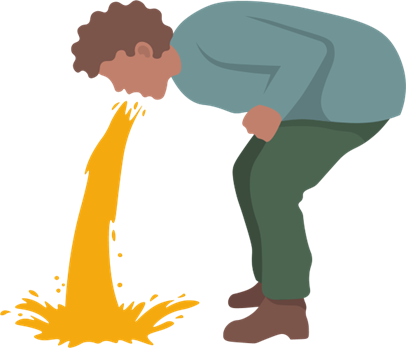A nurse is caring for a 6-week-old infant who has pyloric stenosis. Which of the following clinical manifestations should the nurse expect?
Distended neck veins
Rigid abdomen
Projectile vomiting
Red currant jelly stools
The Correct Answer is C
Choice A: Distended neck veins are not a clinical manifestation of pyloric stenosis, which is a condition that causes the narrowing of the pylorus, which is the opening between the stomach and the small intestine. Distended neck veins are a sign of increased venous pressure, which can occur in conditions that affect the right side of the heart or cause fluid overload.
Choice B: Rigid abdomen is not a clinical manifestation of pyloric stenosis, but rather a sign of peritonitis, which is inflammation of the peritoneum, which is the membrane that lines the abdominal cavity. Peritonitis can be caused by infection, perforation, or trauma to any abdominal organ. A rigid abdomen indicates severe pain and inflammation in the abdominal cavity.
Choice C: Projectile vomiting is a clinical manifestation of pyloric stenosis, as it indicates forceful expulsion of stomach contents due to obstruction at the pylorus. Projectile vomiting can occur shortly after feeding and may contain undigested milk or formula. Projectile vomiting can cause dehydration, electrolyte imbalance, or weight loss.
Choice D: Red currant jelly stools are not a clinical manifestation of pyloric stenosis, but rather a sign of intussusception, which is a condition that causes telescoping of one segment of bowel into another. Intussusception can cause obstruction and ischemia of the bowel and lead to bleeding and necrosis. Red currant jelly stools indicate blood and mucus in the stool.

Nursing Test Bank
Naxlex Comprehensive Predictor Exams
Related Questions
Correct Answer is D
Explanation
Choice A: Loosening restrictive clothing is not the priority action, but rather a secondary action for a child who is having a tonic-clonic seizure and vomiting. A tonic-clonic seizure is a type of seizure that involves the stiffening of muscles (tonic phase) followed by jerking movements (clonic phase). Loosening restrictive clothing can prevent injury or discomfort to the child during or after the seizure.
Choice B: Placing a pillow under the child's head is not the priority action, but rather an inappropriate action for a child who is having a tonic-clonic seizure and vomiting. A pillow under the head can obstruct the airway or cause aspiration of vomitus into the lungs. The nurse should remove any pillows or objects from around the head and neck area and support the head with their hands or on a flat surface.
Choice C: Clearing the area of hazards is not the priority action, but rather a secondary action for a child who is having a tonic-clonic seizure and vomiting. Clearing the area of hazards can prevent injury or harm to the child or others during or after the seizure. The nurse should remove any sharp, hard, or flammable objects from near or under the child and move any furniture or equipment away.
Choice D: Positioning the child side-lying is the priority action for a child who is having a tonic-clonic seizure and vomiting, as it can protect the airway and prevent aspiration of vomitus into the lungs. Aspiration can cause pneumonia, which is an infection of the lungs that can cause fever, cough, difficulty breathing, or death. The nurse should turn the child's head to one side and place them on their side with their knees bent and one arm under their head. The nurse should also suction any vomitus from their mouth and nose if needed.
Correct Answer is D
Explanation
Choice A: Ibuprofen is a nonsteroidal anti-inflammatory drug (NSAID) that can be used to relieve pain and inflammation in children with influenza. Ibuprofen does not increase the risk of Reye syndrome, which is a rare but serious condition that affects the brain and liver.
Choice B: Grapefruit juice is a citrus fruit that can provide vitamin C and hydration for children with influenza. Grapefruit juice does not increase the risk of Reye syndrome, but it can interact with some medications and affect their absorption or metabolism.
Choice C: A humidifier is a device that adds moisture to the air and can help ease congestion and coughing in children with influenza. A humidifier does not increase the risk of Reye syndrome, but it should be cleaned regularly to prevent bacterial growth and infection.
Choice D: Aspirin is a salicylate that can be used to reduce fever and inflammation in children with influenza. However, aspirin can increase the risk of Reye syndrome, especially in children who have viral infections. Reye syndrome can cause swelling in the brain, liver damage, and even death. Therefore, aspirin should be avoided in children under 19 years old who have influenza or other viral illnesses.
Whether you are a student looking to ace your exams or a practicing nurse seeking to enhance your expertise , our nursing education contents will empower you with the confidence and competence to make a difference in the lives of patients and become a respected leader in the healthcare field.
Visit Naxlex, invest in your future and unlock endless possibilities with our unparalleled nursing education contents today
Report Wrong Answer on the Current Question
Do you disagree with the answer? If yes, what is your expected answer? Explain.
Kindly be descriptive with the issue you are facing.
